First Drive: 2026 Aston Martin Vanquish Volante Delivers Open-Air V12 Ferocity
Few drives spark anticipation like this one: The 2026 Aston Martin Vanquish is the fastest and most powerful front engine production machine on sale today – eclipsing Ferrari’s 12Cilindri by a fistful of horsepower – and the Volante I’ve got my hands on is the drop-dead gorgeous soft-top version that becomes available in the second half of 2025. It promises more than just open-air elegance – it also delivers epic firepower.
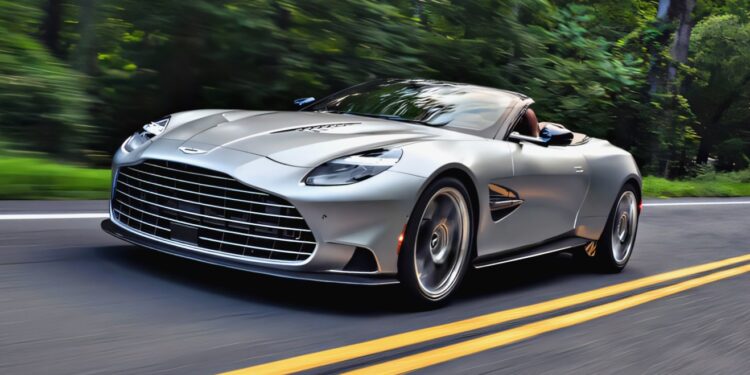
It looks quick while standing still outside Aston Martin’s Q New York flagship U.S. showroom, svelte Satin Aluminite Silver colors shimmering as the summer sun peeks around the surrounding skyscrapers, quickly reverting to matte gray when a cloud steals its light source. The Vanquish is the fourth ‘showroom revolution’ model that’s been launched by Aston Martin in the last 18 months, following on from the Vantage, DB12 and the DBX707 (coupled with the sporty S sibling – its top-end super SUV). But they’re all V8s – and the Vanquish’s V12, a completely new engine design that’s hand-built in the UK, actually predates them all with its five-year gestation period.
“It is all about this engine; it really does quite define the driving experience,” explains Simon Newton, Vehicle Attribute & Performance Director, before our drive. “Aston recognized that they wanted to continue with the V12 legacy and, as such, had to put a lot of time and effort into producing a unit which is significantly up in terms of power and torque, as well as meeting the latest emissions standards.”
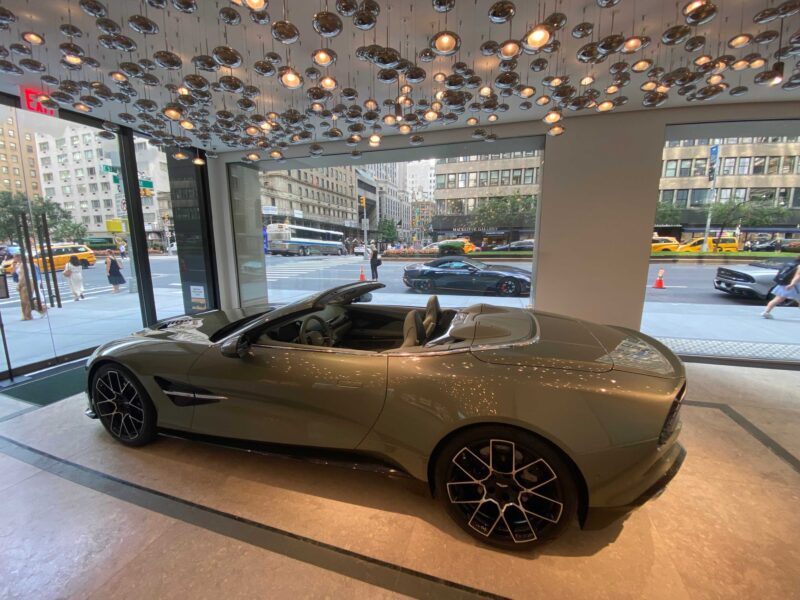
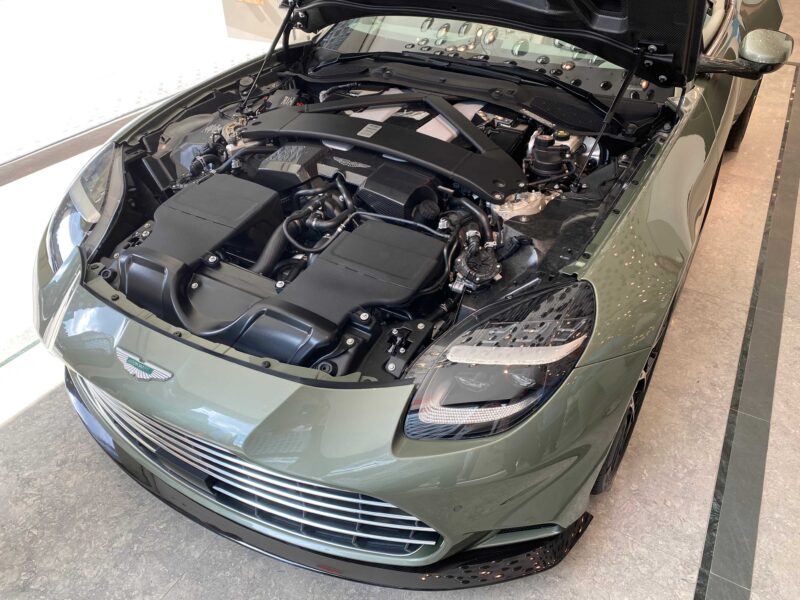
In fact, it’s been 25 years since Aston Martin first launched V12-powered Coupe and Volante models, with 2000’s DB7 Vantage. Back then, you got a 5.9-liter engine, producing 420 horsepower and 400 lb-ft of torque, and a top speed ‘nearing’ 186 mph. Today, it’s the third-generation range-topping Vanquish that boasts a fresh 5.2-liter V12, flanked by twin-turbos, producing 824 hp (yes, that’s almost twice the power) and 738 lb-ft of torque (338 more). With a 0-62 mph time of 3.4 seconds, it’s one metric that is slightly inferior to the 12Cilindri, presumably due to the Vanquish’s turbo lag.
This V12 develops maximum torque at just 2500rpm – precisely half the engine speed required by its forebear of 25 years ago – and maintains that 1000Nm peak all the way from 2500-5000rpm, until reaching its maximum speed of 214 mph. Despite modern safety demands, the 2026 version has only added 95kg, increasing its power-to-weight ratio from 313hp per tonne to a staggering 416hp per tonne.
The performance stats are impressive, but the design tells its own story: Two vein-like carbon-fibre vents sit atop the hood, with F1-inspired fluting venting hot air from a hungry engine fed by that full-width grille that dominates the head-on aspect. While I’m not a huge fan of gaping maws, the design from the tip of its nose then flows satisfyingly throughout, all beginning with the elegantly expansive front end; the aesthetic truly emphasizes the car’s assertive proportions.
“The length of the hood is part of the drama of Vanquish; it’s really accentuating the wheelbase, that dash-to-axle area, showing the power and grace of the car,” says Marek Reichman, EVP & Chief Creative Officer. “The shark nose emphasizes the length to the windshield base, and the proportion that the car has, with the front wheels pushed forward, gives an assertive, almost aggressive stance.”
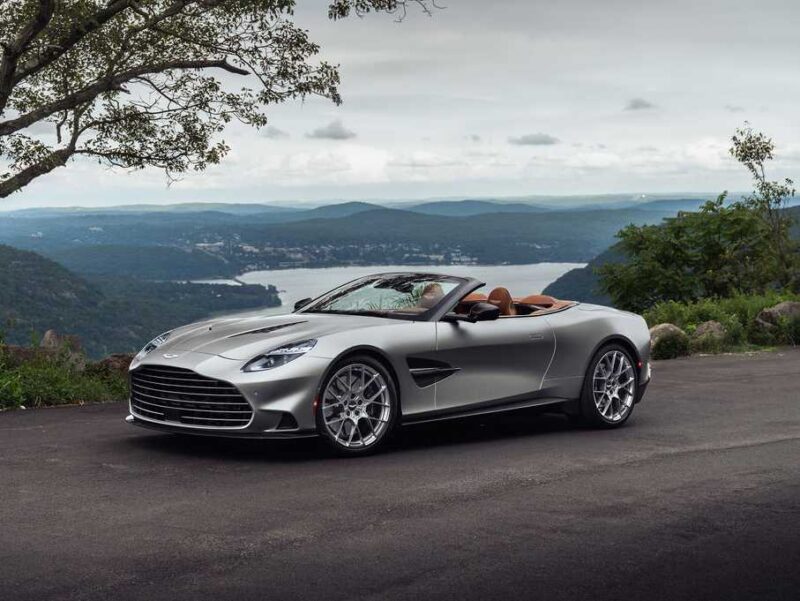
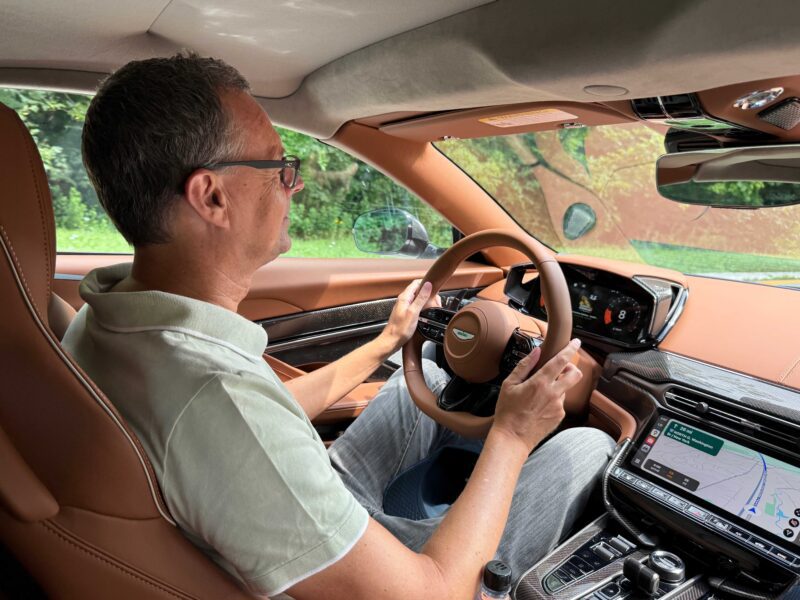
With those extra four cylinders adding chassis heft behind the front wheels, the design messaging is reinforced by a triangular carbon fiber side strake, reminiscent of the DBR1 racer, which carries the ‘ASTON MARTIN V12’ moniker, and probably explains why an NYC traffic officer saunters up as I crawl through the morning traffic: “This the V12, right?” he asks, the first of many people to do likewise, or give the thumbs up. This car is already bringing joy to the masses, and I haven’t even got to the best bit yet!
After escaping the city’s stranglehold, it’s time for the Vanquish to finally bring the power. And how. When it’s in regular GT driving mode, it loves to quietly saunter up to eighth gear – let’s say in true grand tourer fashion. But engage Sport mode, or the completely manic track-inspired Sport +, and rattle down to the lower gears, the Jekyll-and-Hyde transformation begins with a stab of the throttle pedal on the open highway. After a short lag, those twin turbos kick in too, which sends your heart racing even further. Make no mistake, this car is insanely fast. Suddenly, the Vanquish is less luxury tourer and more ballistic missile.
Even better, with no electric motors, no complex hybrid system, just a barking V12 ICE motor that sings its glorious song, harmonized by the turbos and echoed by a titanium exhaust, this feels like pure performance from a proper old school powerplant, the rear wheels alone are fed by an eight-speed ZF automatic gearbox located within the rear axle for optimal weight distribution.
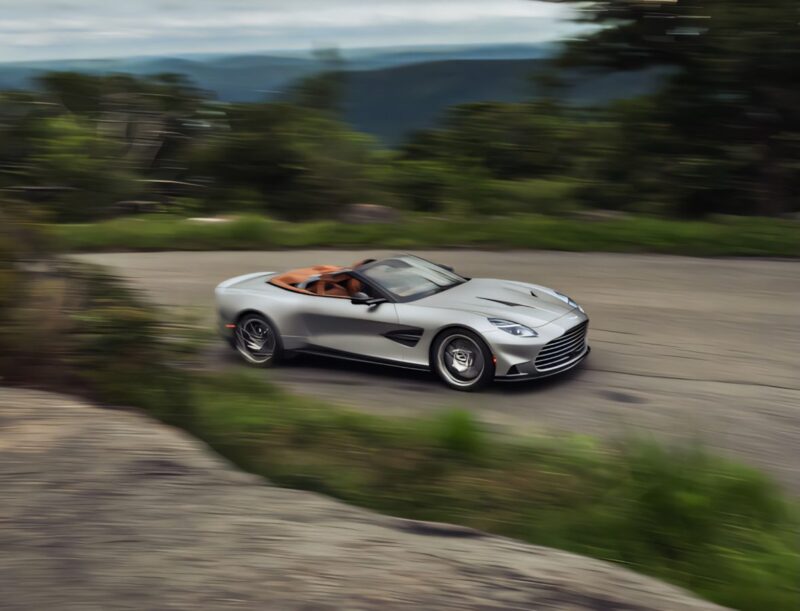
Power is nothing without control: The Vanquish Volante incorporates the same rear E-differential used by its sibling Vanquish Coupe. Capable of transitioning from fully open to 100% locked in 135 milliseconds, the E-diff provides incredible bandwidth and benefit – which is starkly apparent when I transition to a country road from the highway. Coupled with Electronic Stability Programme (ESP) technology, it aims to ‘shorten’ the wheelbase in tighter corners by giving it rotational response to steering input. The ESP also offered Track and Wet modes; today I require neither.
On the bumps and gravel strewn surfaces, attempting full throttle means that its traction control intervenes assertively – but once you learn its rhythm, the power is progressive, and quite intoxicating. With a little right-footed finesse and forethought, all those horses remain on tap, giving you a pure beaming grin of a driving experience, just knowing that the Vanquish can leap into hyperspace mode whenever you desire.
It just wants you to do that on its terms; I did feel the tiniest hint of wheelspin in third gear while playing with throttle demands, so you still must be careful. Lean on the throttle steadily, and the revs and speedo rattle upwards almost ridiculously fast. Completely stamp on it and… well, I’d imagine a fully prepared drag racing strip would be an absolute hoot, especially with its “Boost Reserve” device engaged! On a twisting road, working progressively with the power makes driving the Volante a compelling experience. Drive like a rock ape, and I’d imagine it would eventually bite you back.
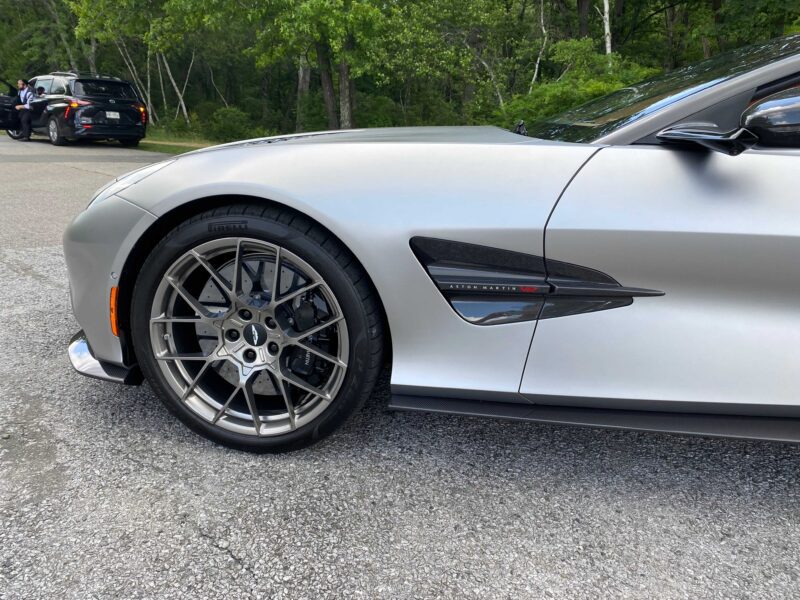
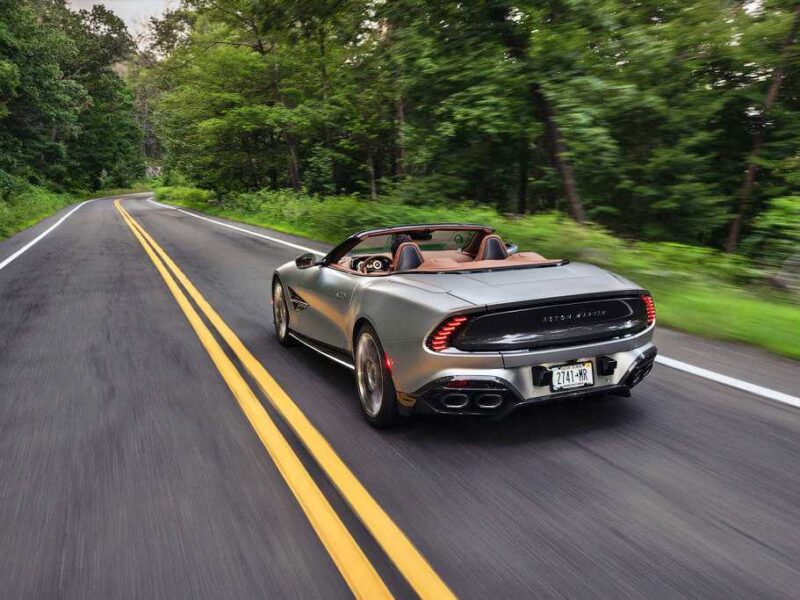
In terms of ride, the Volante feels firm yet not bone shaking. But as soon as you explore the power on offer, you realize this car requires a solid platform from which to connect with the road – to harness all that power. Handling-wise, our meandering country backroad route that took in Lake Welch, the road around Harriman State Park and eventually up to Valley Rock Inn & Mountain Club, provided challenging corners, many with blind crests – and the odd startled deer – and, at one point, a Police car completely blocking the road! The Vanquish’s carbon ceramic brake system came into its own at that point, as we followed his unexpected diversion into what felt like the middle of nowhere…
The Volante’s 50/50 weight distribution (actually superior to the Coupe’s 51/49) is aided by the location of the retractable roof, its mechanism and the safety roll bars between the rear wheels. Extra carbon fiber bracing and stiffer front anti-rollbars, plus Bilstein DTX dampers, means there’s no float that you might expect from a convertible. I found that I had to drive it really badly into a hairpin, charging the corner, to unstick the front end, but it quickly responded with grace and helped me out with the minimum of fuss.
The steering felt a tad heavy to begin with, but from that initial turn-in, your inputs can be feather-light as it smoothly gobbles up bends, giving good feedback and working especially well in tandem with trail braking into the apex, which helps if a corner suddenly creeps up on you or tightens unexpectedly. Despite its wide dimensions, it doesn’t feel like a big car on a country road or the highway – only in city traffic was I truly aware of how much of the lane the Vanquish was filling, especially when jostling for inches next to a bus or truck.
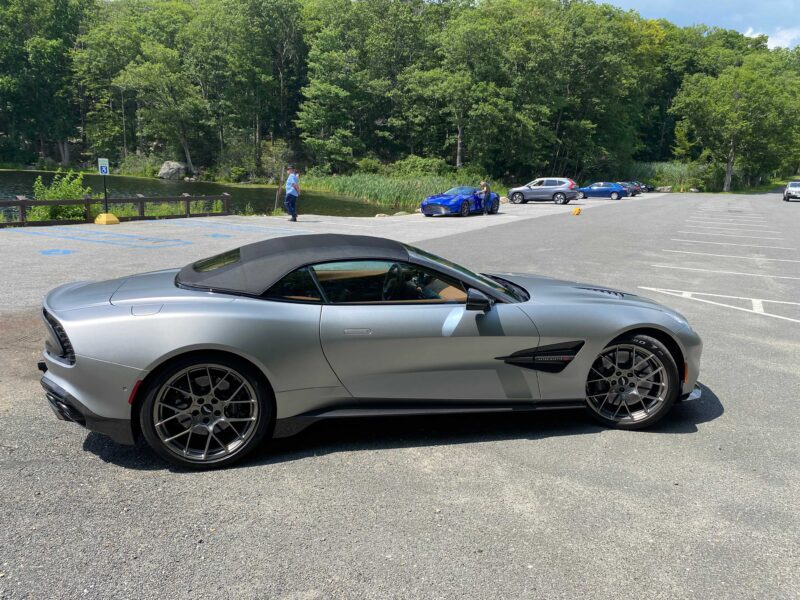
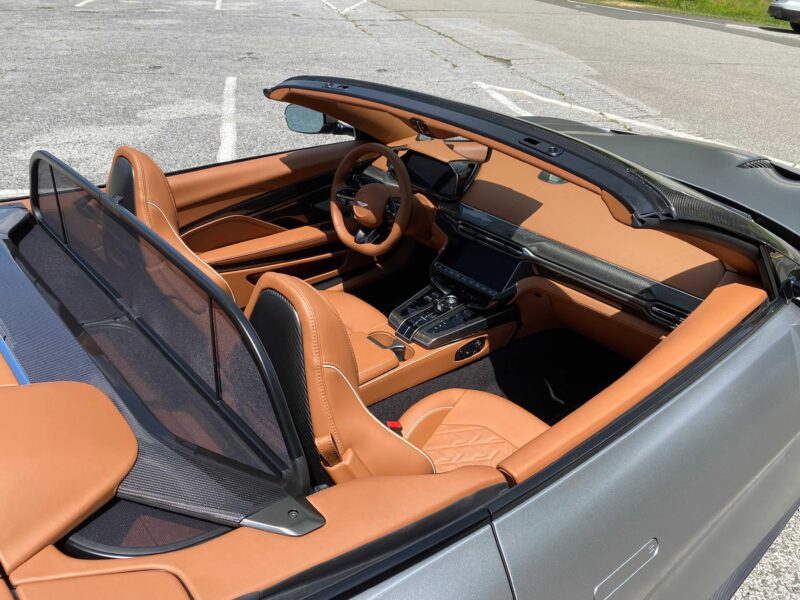
With rain showers threatening, the roof is raised for the return journey to New York City. The Volante sports an innovative K-fold roof, which can fold in 14 seconds and close in 16 at speeds of up to 31 mph, and the car still looks pretty with it in place. Due to its low height when stacked (260mm), this really doesn’t interrupt its flowing lines when it’s down either.
Two things do become apparent with the roof up: Somewhat surprisingly, the engine note resonates even more satisfyingly. With it stowed, wind noise certainly has some influence on the harmonics, although driving with the side windows up helped enormously for in-car conversation. And, secondly, one nitpick I have is that it would benefit from a rear-view camera screen, as the central mirror became slightly obscured by the soft-top’s rear window. I found myself favoring the large external mirrors, like an F1 driver – especially as they’re attached to long, carbon fiber stalks.
On a more leisurely drive back to Q, it was nice to take in the luxurious and airy cabin, which is a true two-seater, with swathes of tan leather, a low-slung driving position, and an amazing dashboard that’s shaped like an art sculpture; the Vanquish Volante truly is a symphony of British craftsmanship. The central console design features a mix of buttons and machined billet aluminum, with everything to hand with a nice touch and feel. It leads up to a 10.25” screen that features the convenience of Apple’s CarPlay Ultra system.
Aston Martin’s Q department also provides the potential for a dizzying range of colors, luxurious finishes and materials, both inside and out, made for customers to create unique configurations: “Whatever you desire, you can create – carbon infills, different leathers, you can even anodize the rotaries in different colors,” adds Reichman of the interior options.
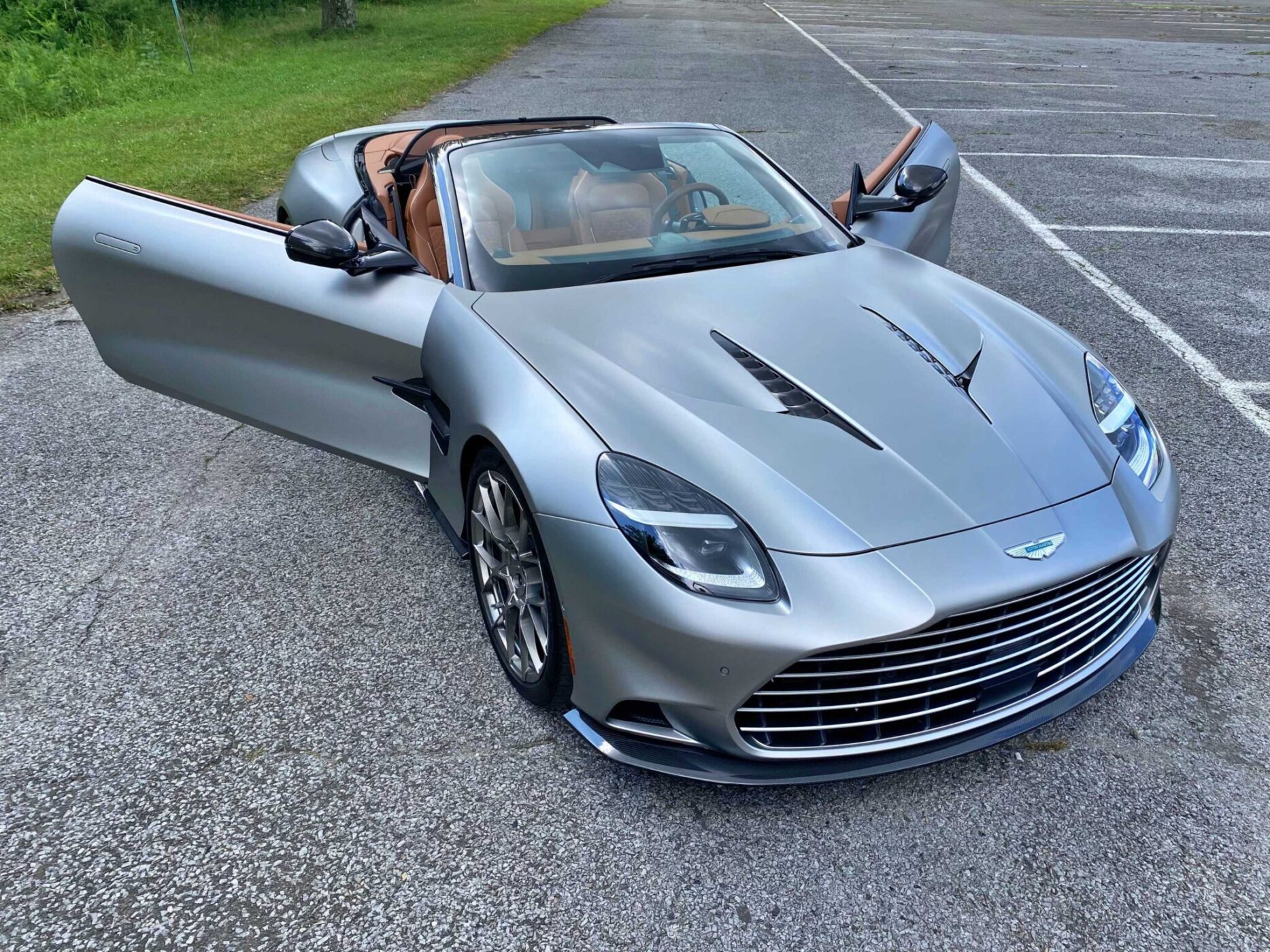
1 of 8

Of course, all the luxury and performance comes at a Bentley, Ferrari and Rolls-Royce rivaling cost. Suggested retail pricing for Vanquish Volante starts at $483,000, with the options-laden version I drove coming in at $595,300. But it’s a lot of car for a lot of money.
At one point it seemed that the Vanquish nameplate might never return, after its second-gen run ended in 2018, and there was even talk of it becoming a mid-engined supercar. The best news is that Aston Martin has chosen to retain front-engined Vanquish heritage, with a production run of 1,000 expected to be built over a calendar year, and about a third of those coming to the U.S.
Speed and performance metrics, backed up by its Formula 1 and endurance racing programs, now matters as much to Aston Martin as comfort and luxury – even for the drop-top version of this crown jewel. We should rejoice that it’s back; the Vanquish Volante is a ferociously handsome brute that makes the sports car world an infinitely better place.
Review: 2025 BMW M5 Touring Weighs In As A Great Allrounder
by Kirk Bell
in 5-Series, BMW News, M5, Reviews

Most car buyers still think of wagons as boring mom machines with fake wood paneling. But to automotive enthusiasts, any performance car is cool, and a performance wagon is even better. It offers the practicality of a crossover with the handling of a car. Ideal. If you know, you know.
The 2025 BMW M5 Touring is definitely an IYKYK machine, but its plug-in hybrid powertrain creates compromises. With 717 horsepower, it’s the most powerful M5 yet, but it’s also slower than the last-generation model due to a big weight increase, and it costs appreciably more as well. So, was it worth it for BMW to add a green aspect to its midsize performance machine? That’s a matter of priorities.
Slower or not, the new M5 remains stunningly quick. Its twin-turbocharged 4.4-liter V8 makes 577 horsepower and teams up with a synchronous electric motor in the eight-speed automatic transmission to produce a whopping 738 pound-feet of torque to go with its 717 horsepower. The motor aids acceleration with up to 194 horsepower and 207 pound-feet of its own, and that torque is available from a stop, so there is no noticeable turbo lag.
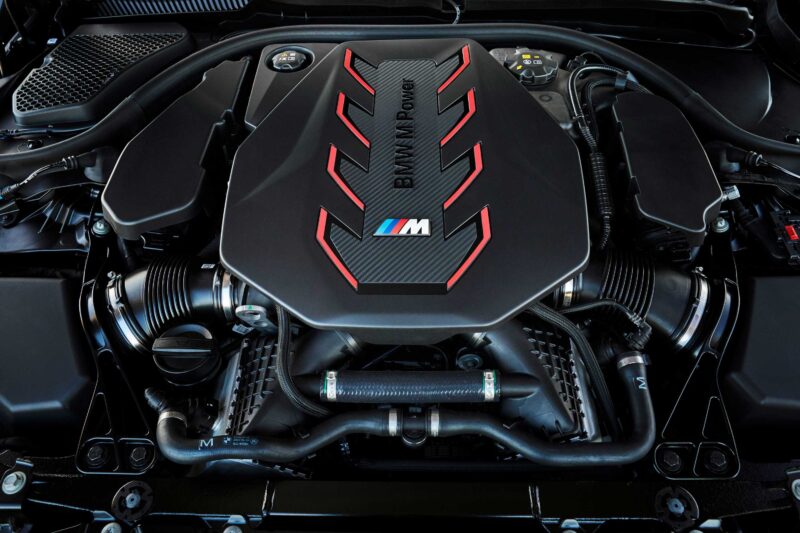
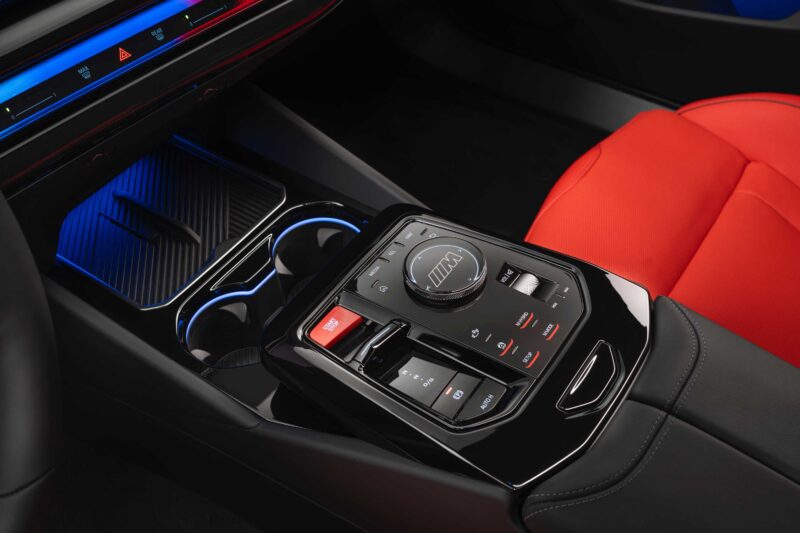
The engine belts out a deep, rising thrum, especially with the artificial M Sound enabled. It supplies relentless neck-snapping thrust when I dig deep into the throttle. BMW quotes a 0-60 mph time of 3.5 seconds, and it feels every bit as fast as that. However, Car and Driver recorded a 2.6-second 0-60 mph time for the previous generation M5 Competition sedan, which used a 627-horsepower version of the same engine and weighed in at 4,096 pounds. The M5 Touring tips the scales at an astonishing 5,530 pounds.
The powertrain’s behavior can be tailored to the driver’s taste. BMW doesn’t provide drive modes, per se, but the Setup button on the center console lets drivers program the red M1 and M2 toggles on the steering wheel and choose settings for the drivetrain, regenerative braking, transmission, suspension, steering, brakes, all-wheel-drive system, and engine sound.
An M Hybrid button on the center console adjusts the hybrid system, too, offering an Electric mode, balanced hybrid assist for improved fuel economy, or dynamic hybrid assist for extra power. Thanks to a 14.8-kWh battery, Electric mode allows for 25 miles of full electric driving as long as you don’t exceed 87 mph or push the accelerator past a detent at the end of pedal travel.
I recommend using the battery as often as possible for normal commuting to get the most benefit. Otherwise, the M5 Touring returns just 13 mpg in combined city and highway driving, according to the EPA. I’m averaging 13.7 mpg over 141 miles of mixed driving. The M5 mostly charges the battery on its own, either with regenerative braking or with the engine. Owners can also charge it in a few hours on a Level 2, 240-volt outlet via the 11-kW onboard charger.

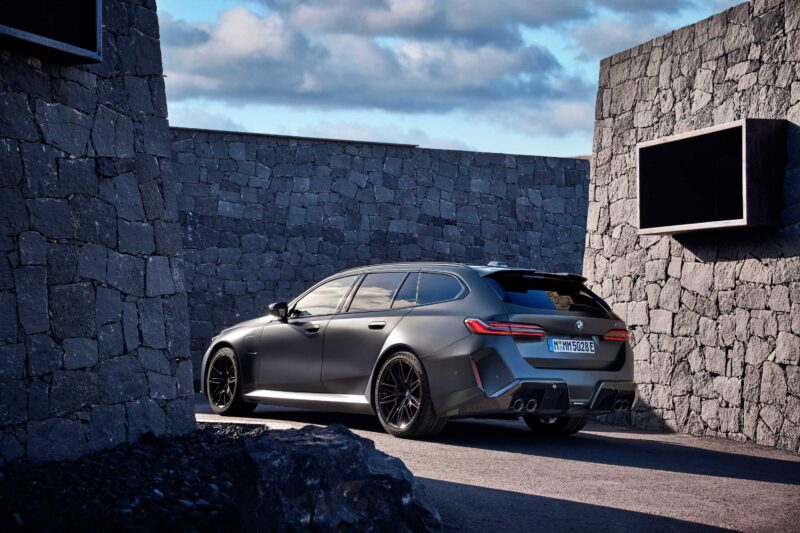
At 200.6 inches long on a 118.3-inch wheelbase, the M5 Touring is 3.2 inches longer than the last-generation sedan on a wheelbase that’s 0.9 inch longer — another reason it’s gained weight. For perspective, it’s almost two inches longer than the three-row Ford Explorer, and it weighs about as much as a Chevy Tahoe.
But BMW does what it can to mask the weight and provide the track-ready handling M5 buyers expect. The M5 retains a double-wishbone front suspension, a five-link rear suspension, and adaptive dampers, but BMW saves weight by employing aluminum and unique sheet metal construction for the front suspension components. The toe and camber links, and the trailing arms are revised to improve dynamics, and numerous M-specific braces are employed throughout the body to increase longitudinal and torsional stiffness.
This all combines with a near-perfect 50/50 front-to-rear weight balance to help the M5 Touring wear its weight well. On a twisty road, that includes a 180-degree switchback, the M5 stays planted and rotates with neutral balance. The 285/40ZR20 front and 295/35ZR21 rear Pirelli P Zero R tires provide stubborn grip, and the big body barely leans in defiance of the G forces acting upon it. When I get on the throttle a little before the apex, the standard electronically controlled rear differential lock shifts power to the outside rear wheel to help mitigate understeer and send me rocketing out of the corner.
When the road gets rough, I adjust the M2 mode to choose the dampers’ Comfort setting. Even then, the ride is overly firm, which could turn off some buyers. The variable ratio steering gets quicker the farther I turn the wheel and tops out at a 14.2:1 ratio. It’s quick and direct, but like most BMWs these days, it’s light to the touch and offers little road feel through the chunky steering wheel. Standard rear-axle steering can turn the rear wheels up to 1.5 degrees opposite of the fronts, but in faster corners, it’s actually turning slightly with the fronts to provide stability.
My test car wears the optional ($8,500) M Carbon ceramic brakes that save 55 pounds of unsprung weight. The massive 16.5-inch front rotors are grabbed by gold six-piston calipers, and single-piston rear calipers clamp down on 15.7-inch rear rotors. That’s a lot of braking power, but this is a lot of car.
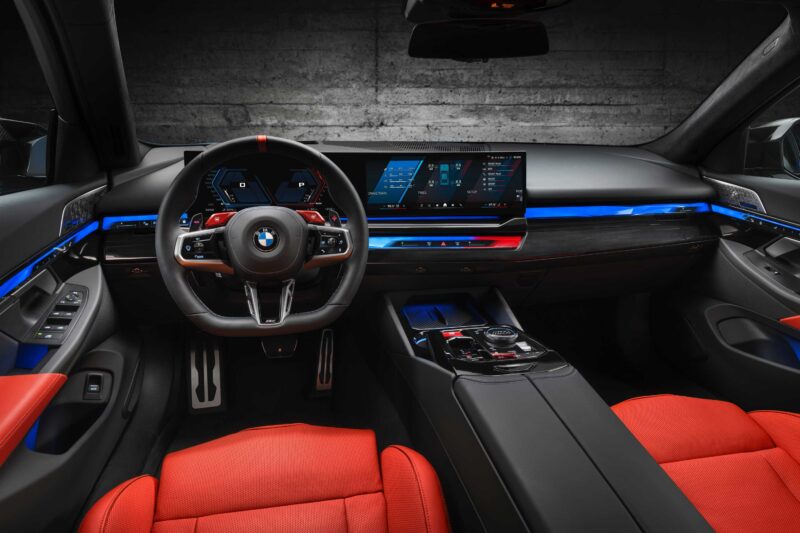
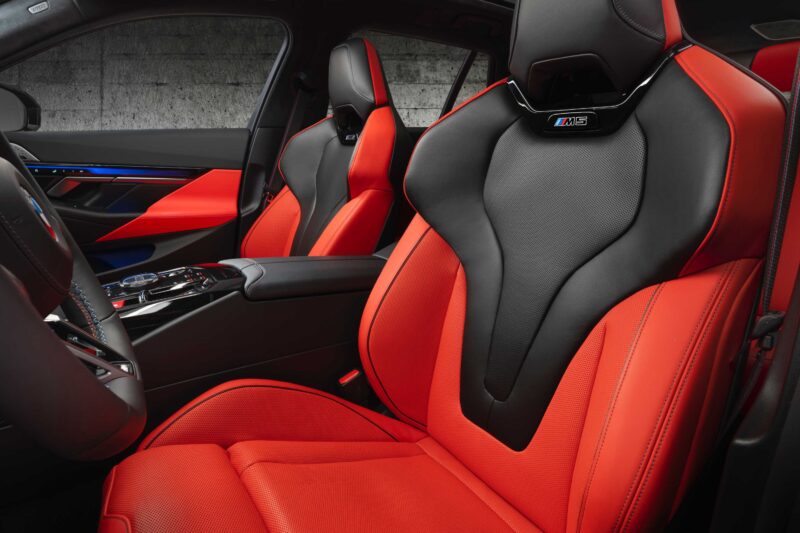
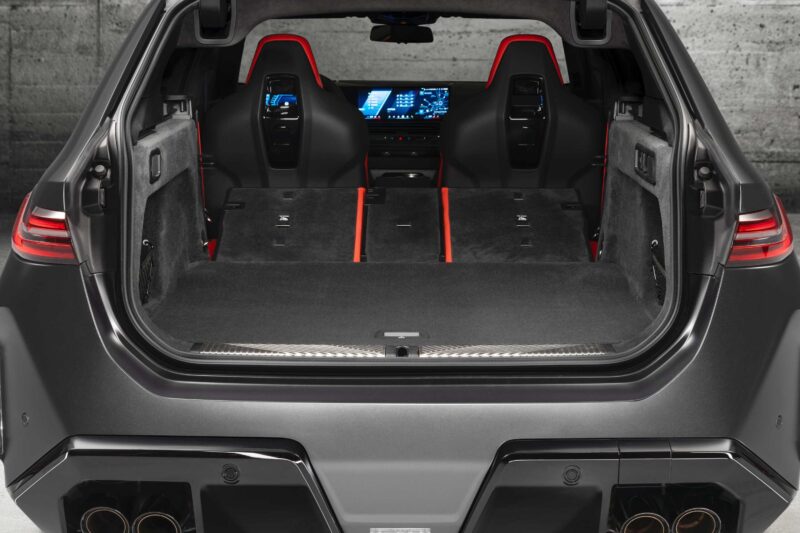
The cockpit has a sporty, extroverted look with its carbon-fiber and piano black trim and two-tone black and cherry tomato red leather that extends to the dash and doors. Technology is at the forefront, too, with a standard one-piece curved display that includes a 12.3-inch digital instrument cluster and a 14.9-inch touchscreen. When parked, owners can stream YouTube videos on the touchscreen or play games on the screen using their phones as the controller. Voice commands can be used for in-car controls, such as adjusting the seating position or setting the temperature.
The front buckets are wide enough for larger drivers, and they hold me firmly in place during aggressive cornering. The second-row seats are comfortable and supportive as well, but the biggest advantage of the Touring body style is cargo space. It boasts 17.7 cubic feet of cargo room behind the second row, and that expands to a generous 57.6 cubic feet with rear seats folded down.
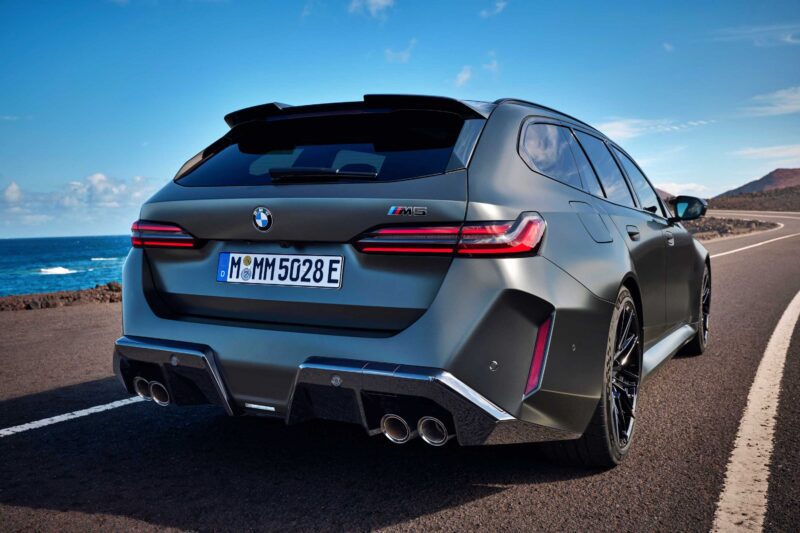
The 2025 BMW M5 Touring is priced at $125,275, which includes a $2,600 gas-guzzler tax and an $1,175 destination fee. That tops the 2023 M5 sedan (there was no 2024 model) by more than $15,000. It’s larger than the outgoing car, and slower both in a straight line and around a track. However, with 25 miles of all-electric range, most commutes can be handled without gas. The wagon body style also gives the Touring most of the practicality of a compact crossover SUV. That all makes the 2025 BMW M5 Touring a great all-around performance car, even though you wouldn’t expect a wagon to be so quick. IYKYK.
Maserati Celebrates Racing Success At Misano

Maserati celebrates a big win in the latest chapter of its racing legacy.
Maserati is very close to celebrating the 100th anniversary of its legendary Trident logo, as well as its presence and undeniable impact on the motorsport world. However, it was much more recently when the iconic luxury Italian performance car manufacturer decided to spur on the revival of its historic racing legacy with the introduction of its MC20 supercar. Succeeding the MC12, the MC20 not only set a new precedent for Maserati supercars, but served as the basis for a new racing era for the brand like the MC12 did.
The MCXtrema racing supercar, the GT2 Stradale, and the new Maserati GT2 race car have all emerged, based on the MC20. Now, the Maserati GT2 has emerged from round 4 of the GT2 European Series at Misano with positive results that are proving Maserati’s place as a formidable name in the motorsport universe.
1 of 7

At the race, Maserati secured two runner-up positions overall, as well as one pole position, with two victories in the Am Cup, and second place in the Pro-Am Cup. In addition to Maserati’s victorious vehicles that took part in the racing, the leading car at Misano was a Maserati MCXtrema, which featured a special livery meant to pay homage to the 20th anniversary of Maserati’s incredible victory at the 24 Hours of Spa, the first achieved by the MC12. With a rich racing history to celebrate already, Maserati’s recent performance at Misano proves that it’s not resting on its motorsport laurels.



